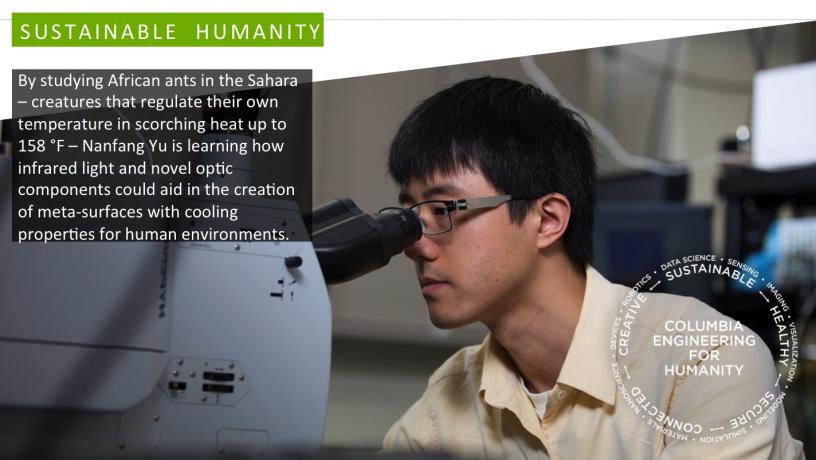Nanfang Yu
ASSOCIATE PROFESSOR OF APPLIED PHYSICS AND APPLIED PHYSICS AND APPLIED MATHEMATICS
201 S.W. Mudd
Mail Code 4701
Yu studies the interaction between light and structured active materials at the nanometer scale and builds novel devices including lasers, detectors, and active components for controlling light. He has found that nanostructured materials usually turn out to be superb solutions for the generation, control, and detection of infrared waves with long wavelengths. For example, quantum cascade lasers, the most popular coherent infrared light sources, are made of semiconductor superlattices, which comprise a stack of nanometer-thick semiconductors, the thinnest layer being only a few atoms thick.
Research Interests
Optics, Plasmonics and Metamaterials, Semiconductor Physics and Devices, Infrared Optics and Optoelectronic Devices, Reconfigurable Metainterfaces Based on Phased Optical Antenna Arrays,, Mid-Infrared and Terahertz Quantum Cascade Lasers, Infrared Imaging and Spectroscopy, Graphene Optoelectronic Devices, Phase-Transition Material.Yu and his lab work to create a new class of flat optical components, the thicknesses of which are just one-thousandth of a human hair and yet are able to do all the jobs conventional, bulky optical components can do. These flat optical devices are made of a two-dimensional array of nano optical scatters, which can individually and abruptly change the amplitude, phase and/or polarization of the scattered light. Together, the array of scatterers can dynamically mold optical wavefronts into arbitrary shapes with ultra-high speed.
Yu believes flat optics are the key to creating modulators for infrared light, which will open up completely new application areas such as all-weather free-space optical communication and remote-sensing optical radar.
To build better infrared detectors and communication systems, Yu probes the clever strategies developed by infrared-sensing organisms over their long evolutionary history. He is conducting interdisciplinary research with biologists and ecologists, exploring ways in which certain insects are able to detect broadband thermal radiation with extremely high sensitivity and spatial accuracy, or detect infrared “fingerprint” emissions from chemicals with high specificity. These studies will have a broad impact on novel heat-sensing devices and chemical detection systems.
Yu received a B.S. in Electrical Engineering from Peking University in 2004 and a Ph.D. in Engineering Sciences from School of Engineering and Applied Sciences at Harvard University in 2009. Yu joined Columbia University in 2013 after completing his doctoral and postdoctoral work at Harvard University. At Harvard, Yu worked extensively on plasmonics, metamaterials, and mid-infrared and terahertz semiconductor lasers. He is a contributing member of a number of professional societies including the Optical Society of America, the IEEE Photonics Society, the American Physical Society, and the Materials Research Society.


RESEARCH EXPERIENCE
- Adjunct Associate Research Scientist, Columbia University, Jul.2012 – Dec.2012
- Research Associate, Harvard University, Jul.2010 – Dec.2012
- Postdoctoral Researcher, Harvard University, Jun.2009 – Jun.2010
PROFESSIONAL EXPERIENCE
- Assistant Professor of Applied Physics, Columbia University, Jan. 1 2013 – present
HONORS & AWARDS
- 2015 Defense Advanced Research Projects Agency Young Faculty Award (DARPA YFA)
- 2016 Office of Naval Research Young Investigator Program (ONR YIP) Award
- 2017 DARPA Director’s Fellowship
SELECTED PUBLICATIONS
- Z. Li, M.-H. Kim, C. Wang, Z. Han, S. Shrestha, Adam C. Overvig, M. Lu, A. Stein, A. M. Agarwal, M. Lončar, and N. Yu, “Controlling propagation and coupling of waveguide modes using phase-gradient metasurfaces,” Nature Nanotechnology (2017)
- Z. Li, Y. Zhou, H. Qi, Q. Pan, Z. Zhang, N. N. Shi, M. Lu, A. Stein, C. Y. Li, S. Ramanathan, and N. Yu, “Correlated perovskites as a new platform for super broadband tunable photonics,” Advanced Materials vol. 28, 9117–9125 (2016).
- H.-T. Chen, A. J. Taylor, and N. Yu, “A review of metasurfaces: physics and applications,” Reports on Progress in Physics vol. 79, 076401 (2016)
- Zhang, M. Kim, F. Aieta, A. She, T. Mansuripur, I. Gabay, M. Khorasaninejad, D. Rousso, X. Wang, M. Troccoli, N. Yu, and F. Capasso, “High efficiency near diffraction-limited mid-infrared flat lenses based on metasurface reflectarrays,” Optics Express vol. 24, 18024 (2016)
- N. N. Shi, C.-C. Tsai, F. Camino, G. D. Bernard, N. Yu*, R. Wehner*, “Keeping cool: Enhanced optical reflection and radiative heat dissipation in Saharan silver ants,” Science vol. 349, 298–301 (2015) (*co-corresponding authors)
- N. Yu and F. Capasso, “Optical metasurfaces and prospect of their applications including fiber optics,” IEEE Journal of Lightwave Technology vol. 33, 2344 (2015)
- N. Yu and F. Capasso, “Flat optics with designer metasurfaces,” Nature Materials vol. 13, 139–150 (2014)
